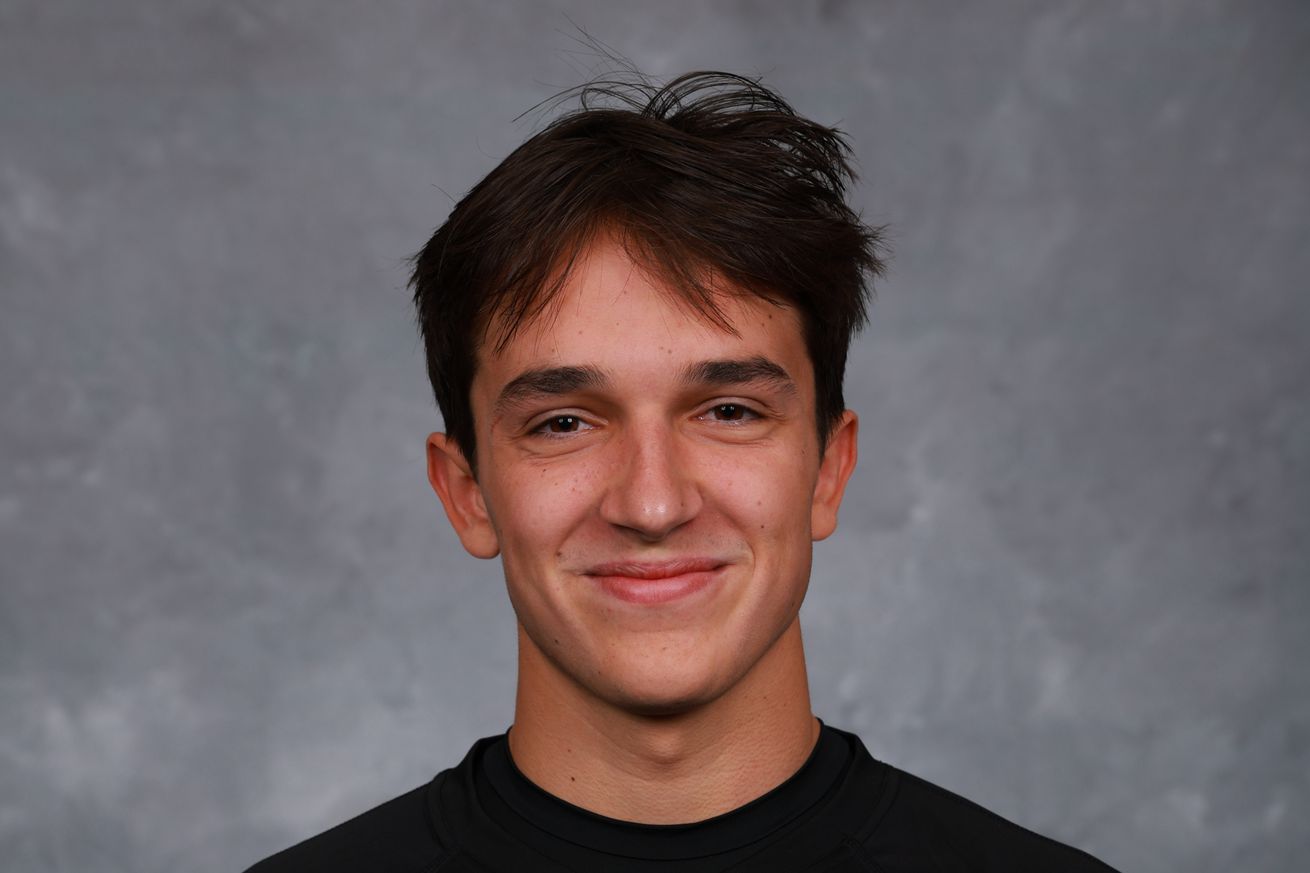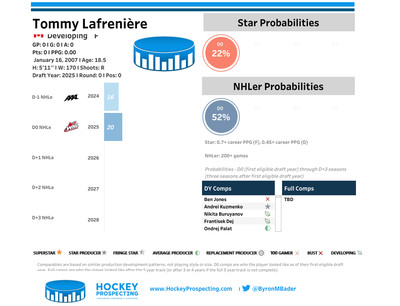
Whether Lafrenière ends up a top six forward or a bottom six center, some team is going to benefit from his attitude and speed.
Who is Tommy Lafrenière?
Tommy Lafrenière was born on January 16, 2007 in Saint-Sauveur, Quebec, a town about an hour northwest of Montreal. While Lafrenière was born in Quebec, he grew up in Western Canada and eventually moved to Abbotsford attend Yale Hockey Academy. Now playing in the Western Hockey League, rocking the Kamloops Blazers jersey for a bit over the past year, he has shot himself from non-consideration for the Draft just a year ago to where he is now. Playing for one of the worst teams in the CHL in 2024-25, Lafrenière was fourth on his team in scoring as the team played to a 24-39-5 record. Listed at 5’11” and 170 pounds on Elite Prospects, Lafrenière has made an impression on the few scouts who have seen him with his drive to get to the front of the net.

Elite Prospects
Now, hopefully the Blazers, who are owned by a team of Dallas Stars owner Tom Gaglardi, Shane Doan, Jarome Iginla, Mark Recchi, and Darryl Sydor, make an effort to really improve their team over the next couple years. I would think that it would be difficult for a prospect like Lafrenière — who has not played much in the CHL to this point — to garner interest from NHL teams when his junior team apparently plays rotten hockey.
Where is Lafrenière Ranked?
Rankings are sourced through Elite Prospects except where linked. Tommy is ranked:
- 57th by NHL Central Scouting (North American skaters — 86th in Mid-Term Rankings)
- 71st by Dobber Prospects
- 76th by McKeen’s Hockey
- 86th by FloHockey — Chris Peters
- 89th by FCHockey
- 110th by Daily Faceoff
- 124th by Elite Prospects
- 161st by Draft Prospects Hockey
- 209th by Recruit Scouting
Lafrenière’s rankings have a bit of range to them.
What Others Have to Say About Lafrenière (and What He Says About Himself)
For The Hockey Writers, Dayton Reimer points out that Lafrenière had some of the best fitness testing results in the recent scouting combine, combining elite endurance with strength above his weight class. However, Reimer still writes that Lafrenière can struggle to win some puck battles, but falls back on great stickwork to create turnovers when he cannot outmuscle larger players. Reimer also says about his skating ability,
Another concern is Lafrenière’s agility. Despite his good top-end speed, the Blazers’ rookie isn’t the cleanest skater, limiting some of his effectiveness without the puck. Once again, he relies heavily on his awareness and active stick to compensate for some of those gaps, and once he gets up to top speed, he is very difficult to catch. Adding another dimension to his skating will take his game to the next level.
If Lafrenière cannot improve his edgework, he may limit himself to a bottom six role in the future. Given his noted intensity, offensive creativity, and shot, Lafrenière has the tools to at least contribute as a bottom six goal scorer. And while Reimer writes that Lafrenière is weaker on defense and in transition (Mitchell Brown and Lassi Alanen’s CHL tracking data agrees with the transition concern, but not so much the defensive), I imagine a good coach would be able to use that popping top speed to the team’s advantage.
Lafrenière’s production profile actually marks him as a potential draft steal, if the third-to-fourth round expectation proves true. When I looked at his card on Byron Bader’s Hockey Prospecting, I found some of his listed similar draft year comparisons to also be real late-round steals, including Ondrej Palat, Lee Stempniak, and Henrik Zetterburg. Of course, there are a lot of busts and replacement-level producers in that mix as well.

Hockey Prospecting
When players like this get to the third round or later, it almost instantly becomes a good idea to pick them — scouts just have to account for how he looks on the ice. For those who watch Lafrenière, they usually rave about his speed, shot, and ability to get to the front of the net, so I do not see an obvious reason why his production cannot continue to improve as he advances to leagues that more and more value the ability to work the puck down the middle. And while Reimer knocked Lafrenière’s agility, his speed is enough on its own to give defenders and goalies fits when he carries the puck with speed through the slot.
In an interview on the WHL This Week radio show, Lafrenière was asked what clicked for him this year to vault himself into consideration for the NHL Draft, considering he was not even drafted in the WHL Draft until the eighth round. He replied,
Yeah, I think it was just kind of just an understanding of just how hard I need to work. I think it’s just kind of clicked inside of me that I need to do more than everyone else and keep pushing myself to be better. And so I just kind of gone the weights a little bit more and gained some weight and took a little bit of height, so it’s definitely helped a lot.
Lafrenière agreed that he took his WHL Draft selection as inspiration to have a chip on his shoulder. He also talked a bit about living a life full of hockey, growing up no, and you can hear the passion in his voice about how much he wants to be on the ice. If a team is looking for someone with the intrinsic motivation to round out his own game and mend some of his weaknesses before even working with an NHL coach, Lafrenière sounds like he has a good head on his shoulders.
A Little Video and My Thoughts
Unfortunately, I was unable to find a full shift-by-shift tape from a game on YouTube for Lafrenière. If you read these profiles, you may know that I really like to see the full games. But we work with what we have in the blogosphere, and we can watch his highlight package from HSD Prospects.
This video, more than anything else, shows that Lafrenière has the skill and offensive attitude to play in the NHL. He might not be an amazing playmaker, but he has the speed and shot to get there. This is a guy who (see: 5:45 in the video) can burn multiple defenders for a breakaway at the end of a long shift (perhaps there is something to that fatigue testing the Combine does). This is not a guy who feeds on bad junior goaltending with long-range shots and peripheral plays that won’t work at higher levels. Lafrenière creates offense in the way you would expect someone in the NHL to. Even on the power play, Lafrenière finds himself in the netfront position, and his renowned ofensive stick does him a lot of good here. Given his size and production, you might expect Kamloops to stick him on the wall or on the bumper. But no: this is a netfront player. He screens, he bats at pucks, he controls the puck well by the goal line, and he takes no time to get shots off around the net.
If Tommy Lafrenière is available when the Devils are on the clock at 90, I would be thrilled — thrilled — if they picked him. I am a big fan of speed and shot combos, and while I am not sure he can play center in the future (not having that shift video hurts me here), I am pretty sure that he can at least be a bottom six spark plug and a monster on the rush and forecheck in addition to his netfront offense. I have seen far too many players come through and play for the New Jersey Devils, only to struggle to pull the trigger when they have the puck with open net to shoot at, but I do not think Lafrenière will fall into that trap when he makes the NHL.
Give this guy two more years with Kamloops and a year or two in the AHL, and I have full faith that Tommy Lafrenière will have built the size and strength necessary to play the game he does now in the NHL. He already has the speed and quickness with the puck, but he needs time. With just a year and nine games under his belt in the WHL, Lafrenière may have been kept out of upper-level competition longer than he should have. But if he played like that as a CHL rookie, I can see him continuing to rise and show his worth to teams.
Your Thoughts
What do you think of Tommy Lafrenière? Do you think he might be one of the mid-round steals of the Draft? Leave your thoughts in the comments below, and thanks for reading.